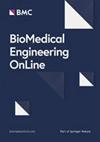使用单个智能手机加速度计识别人类活动中传感器方向和位置问题的简单启发式特征的有效性
IF 2.9
4区 医学
Q3 ENGINEERING, BIOMEDICAL
引用次数: 0
摘要
使用智能手机传感器的人类活动识别(HAR)存在两个主要问题:传感器方向和位置。传感器方位和位置问题是指由于传感器改变方向和位置而导致特定活动的传感器信号发生变化。从原始传感器信号中提取方向和位置不变特征是解决这些问题的简单方法。这种方法使用少量启发式特征,而不是大量时域和频域特征,因此更加简便。启发式特征是受传感器方向和位置影响极小的特征。在本研究中,我们使用 1D-CNN-LSTM 模型评估了四个简单启发式特征在解决传感器方向和位置问题方面的有效性,该数据集由超过 1200 万个样本组成。我们积累了 42 名参与者在六种常见日常活动中的数据:我们从智能手机的单个加速度传感器中积累了 42 名参与者的六种常见日常活动数据:躺着、坐着、走路和跑步,代谢当量分别为 3MET、5MET 和 7MET。我们对智能手机的三种位置进行了研究:口袋、背包和手。我们从加速度计数据中提取了简单的启发式特征,并用它们来训练和测试 1D-CNN-LSTM 模型,以评估它们在解决传感器方向和位置问题方面的有效性。我们进行了位置内评估和位置间评估。在位置内评估中,我们使用来自同一智能手机位置的数据对模型进行训练和测试;而在位置间评估中,训练和测试数据来自不同的智能手机位置。在位置内评估中,我们获得了 70% 到 73% 的准确率;在位置间评估中,准确率在 59% 到 69% 之间。此外,我们还进行了针对特定参与者和特定活动的分析。我们发现,简单的启发式特征在解决定向问题方面相当有效。随着进一步的发展,例如将启发式特征与其他消除定位问题的方法相融合,我们还能取得比使用启发式特征解决传感器定位问题更好的结果。此外,我们还发现启发式特征在识别高强度活动方面更为有效。本文章由计算机程序翻译,如有差异,请以英文原文为准。
The effectiveness of simple heuristic features in sensor orientation and placement problems in human activity recognition using a single smartphone accelerometer
Human activity Recognition (HAR) using smartphone sensors suffers from two major problems: sensor orientation and placement. Sensor orientation and sensor placement problems refer to the variation in sensor signal for a particular activity due to sensors’ altering orientation and placement. Extracting orientation and position invariant features from raw sensor signals is a simple solution for tackling these problems. Using few heuristic features rather than numerous time-domain and frequency-domain features offers more simplicity in this approach. The heuristic features are features which have very minimal effects of sensor orientation and placement. In this study, we evaluated the effectiveness of four simple heuristic features in solving the sensor orientation and placement problems using a 1D-CNN–LSTM model for a data set consisting of over 12 million samples. We accumulated data from 42 participants for six common daily activities: Lying, Sitting, Walking, and Running at 3-Metabolic Equivalent of Tasks (METs), 5-METs and 7-METs from a single accelerometer sensor of a smartphone. We conducted our study for three smartphone positions: Pocket, Backpack and Hand. We extracted simple heuristic features from the accelerometer data and used them to train and test a 1D-CNN–LSTM model to evaluate their effectiveness in solving sensor orientation and placement problems. We performed intra-position and inter-position evaluations. In intra-position evaluation, we trained and tested the model using data from the same smartphone position, whereas, in inter-position evaluation, the training and test data was from different smartphone positions. For intra-position evaluation, we acquired 70–73% accuracy; for inter-position cases, the accuracies ranged between 59 and 69%. Moreover, we performed participant-specific and activity-specific analyses. We found that the simple heuristic features are considerably effective in solving orientation problems. With further development, such as fusing the heuristic features with other methods that eliminate placement issues, we can also achieve a better result than the outcome we achieved using the heuristic features for the sensor placement problem. In addition, we found the heuristic features to be more effective in recognizing high-intensity activities.
求助全文
通过发布文献求助,成功后即可免费获取论文全文。
去求助
来源期刊

BioMedical Engineering OnLine
工程技术-工程:生物医学
CiteScore
6.70
自引率
2.60%
发文量
79
审稿时长
1 months
期刊介绍:
BioMedical Engineering OnLine is an open access, peer-reviewed journal that is dedicated to publishing research in all areas of biomedical engineering.
BioMedical Engineering OnLine is aimed at readers and authors throughout the world, with an interest in using tools of the physical and data sciences and techniques in engineering to understand and solve problems in the biological and medical sciences. Topical areas include, but are not limited to:
Bioinformatics-
Bioinstrumentation-
Biomechanics-
Biomedical Devices & Instrumentation-
Biomedical Signal Processing-
Healthcare Information Systems-
Human Dynamics-
Neural Engineering-
Rehabilitation Engineering-
Biomaterials-
Biomedical Imaging & Image Processing-
BioMEMS and On-Chip Devices-
Bio-Micro/Nano Technologies-
Biomolecular Engineering-
Biosensors-
Cardiovascular Systems Engineering-
Cellular Engineering-
Clinical Engineering-
Computational Biology-
Drug Delivery Technologies-
Modeling Methodologies-
Nanomaterials and Nanotechnology in Biomedicine-
Respiratory Systems Engineering-
Robotics in Medicine-
Systems and Synthetic Biology-
Systems Biology-
Telemedicine/Smartphone Applications in Medicine-
Therapeutic Systems, Devices and Technologies-
Tissue Engineering
 求助内容:
求助内容: 应助结果提醒方式:
应助结果提醒方式:


